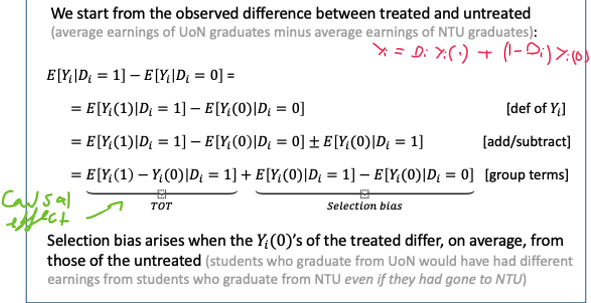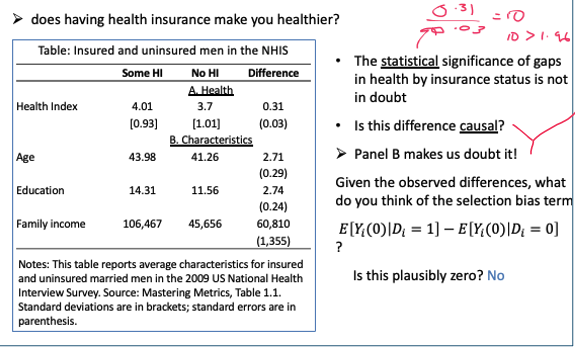Applied econometrics lecture 15 causality
1/22
Earn XP
Description and Tags
Name | Mastery | Learn | Test | Matching | Spaced |
|---|
No study sessions yet.
23 Terms
Non-random sampling
where the sample is not drawn randomly from the population of interest
We assume random sampling
causal Qs and splitting the problem into 2
Identification
Statistics
splitting the problem into 2 - identification
What could we learn about the parameters we care about (causal effects) if we had the observable data for the entire population
Need to make assumptions about how observed outcomes relate to outcomes that would have been realized under different treatments
splitting the problem into 2 - stats
What can we learn about the full population that we care about from the finite sample that we have?
Need to understand the process by which our data is generated from the full population
Indicator for treatment
Di
Outcome under treatment
Yi (1)
Outcome under control
Yi (0)
observed outcome
Di Yi (1) + (1 - Di) Yi (0)
When Di = 1 we only observe Yi (1)
Example estimator


Example estimand


Example target parameter

We cant assume the 2nd term is equal to earning as NTU for NTU grads - due to selection bias / omitted variables
(other ways that affect earnings (regardless of where they went to uni))

Individual treatment effect (TE)
Yi (1) - Yi (0)
Average treatment effect (ATE)
average causal effect between group the unit is in
(affect of attending UoN instead of NTU)
E( Yi (1) - Yi (0) )
Effect of treatment on treated (TOT)
average causal effect of group among those who are part of the group
(of attending UoN among those who attended UoN)
E( Yi (1) - Yi (0) | Di = 1) = E( Yi (1) | Di = 1) - E( Yi (0) | Di = 1)
Selection bias


Does having health insurance make you healthier
As the extra characteristics are statistically different between men with HI and without HI, it makes us believe that the outcome will be different for the 2 populations
The observed difference could come from the selection bias term

Random assignment and selection bias
When treatment status is randomly assigned, selection bias disappears
The potential outcome of the people that are not treated without treatment is the same as the potential outcome without treatment of the people who are treated.

Random assignment and the Uni example
Suppose that UoN & NTU administration randomized who got into which uni
Since university is randomly assigned, the only thing that differs between UoN and NTU students is the university they went to


Random sampling vs Random assignment
Random sampling
facilitates statistical inference about population parameters, causal or otherwise
We generally assume it holds
Random assignment
supports causal inference, that is, comparisons of potential outcomes free of selection bias
we achieve with RTCs
RTCs immoral in many cases
Omitted variable bias (OVB)




using OVB formula to investigate selection bias
The OVB formula is true for any short vs long regression comparison
Why would we want to run a long regression as opposed to a short regression:
Because the potential outcomes ( Yi (0)’s ) are likely different between the treated and the untreated
Regression with the right controls reduces, and maybe even eliminates, selection bias arising from unbalances in Yi (0)’s
Removing selection bias by controlling for OVB
By controlling for the only omitted variable (correlated with our explanatory), we can recover the treatment of the treated → we remove selection bias

Conditional independence assumption
When we have many variables, it is sufficient that Di is ‘randomly assigned’ conditional on x, to recover causal parameter of interest
Di ⊥ Yi (…) | Xi
⊥ - conditional on
Sometimes (rare in reality) that by controlling for the right Xi’s it is sufficient to recover causal parameters of interest